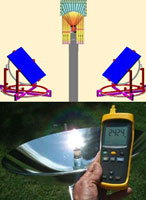New technology increases concentrated solar conversion efficiency by 60 %
27 Aug 2012
Right now, more than 6.5 billion people are competing for the Earth's dwindling supply of fossil fuels. By 2050, it is estimated that there will be 8 to 10 billion, and major advances in energy technology will be required to meet their needs. Rensselaer Polytechnic Institute has faced that challenge by launching and expanding programs in renewable energy sources and energy conservation.
 A promising technology developed at Rensselaer Polytechnic Institute, a private research university located in Troy, New York, uses superconducting magnets to increase the efficiency of conversion from sunlight to electricity by stripping electrons from high-energy plasma jets and thereby generating power with no moving parts. This leads to concentrating solar power through a breakthrough solar power technology utilizing what is known as magnetohydrodynamics (MHD).
A promising technology developed at Rensselaer Polytechnic Institute, a private research university located in Troy, New York, uses superconducting magnets to increase the efficiency of conversion from sunlight to electricity by stripping electrons from high-energy plasma jets and thereby generating power with no moving parts. This leads to concentrating solar power through a breakthrough solar power technology utilizing what is known as magnetohydrodynamics (MHD).
The three co-inventors are Thomas P Kay, founder of Concentrating Solar Power Utility and two Rensselaer faculty members - Douglas Chrisey, professor in the department of materials science and engineering and the department of biomedical engineering, and Yoav Peles, associate professor in the department of mechanical, aerospace, and nuclear engineering.
Magnetohydrodynamics (MHD) is derived from the terms magneto - meaning magnetic field; hydro - meaning liquid; and dynamics - meaning movement. MHD uses magnets and plasma to extract electricity from superheated charged gas, and allows the generation of power directly from the body of the hot gas without the need for any moving parts.
A key benefit of MHD is its ability to operate at higher temperatures, which makes it a strong fit to use in solar power generation.
In a sense MHD replaces the wires used in conventional electrical generators with ionized gas. This rendering depicts the solar MHD device that uses power from the sun to generate electricity. The system can also run on biodiesel or jet fuel JP8. In addition, it can also be used as a topping cycle to improve the efficiency to existing power plants.